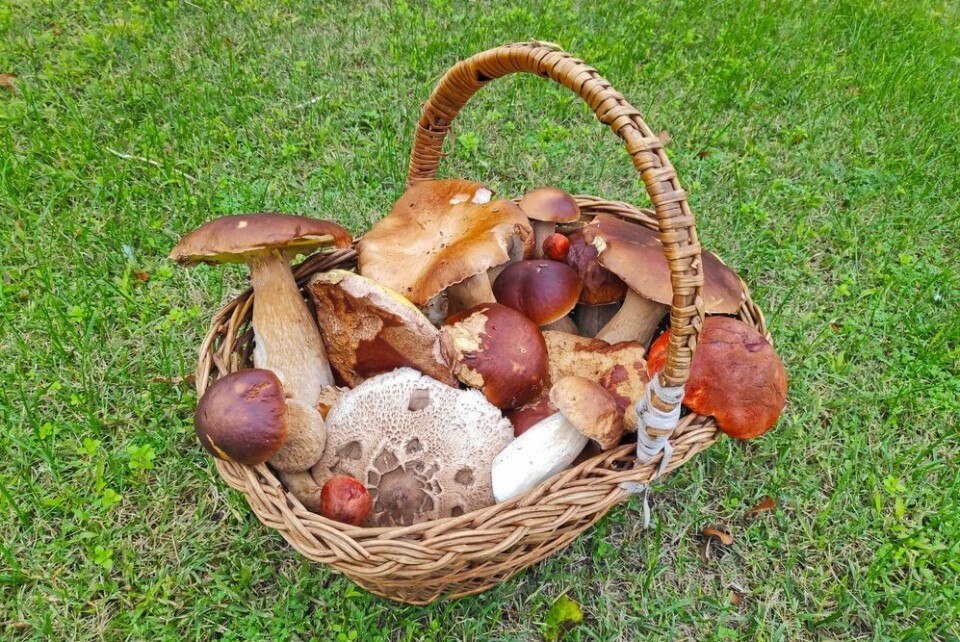-
France targets imports from South America over banned chemical concerns
Avocados, mangoes, and cherries among food items set to be tested before entry
-
Hazelnut, chocolate… pork? France’s traditional galette des rois gets a modern makeover
January 6 marks Epiphany and the famous galette, eaten across France
-
Duck Cold! Four French phrases to use when it is freezing outside
We remind you of French expressions to use to describe the drop in temperature
Early - and good - start to mushroom season in France
Favourable weather conditions have put the fun in fungi this year but pickers are still warned to be vigilant

France’s mushroom season is off to a good start this year, with a ‘surprising number and variety’ available earlier than normal due to favourable weather conditions.
The heat and humidity of the past few days and weeks, especially in regions such as the Ardennes (Grand Est), have caused mushrooms to, well…mushroom.
Guy Christelle, president of the mushroom collecting society the Société mycologique du Sedanais, near Sedan, told France 3 that its recent outing on August 12 was very fruitful.
“We haven’t seen as many as this for a long time. We were really surprised by the number and variety,” he said. “This year, we have had heat and humidity, which is what they need to grow. Last year, it was very dry, so we had to wait until the end of September to have something to put in our baskets.”
Around 30 people attended the picking meeting in the local Sommauthe wood. Mr Christelle said: “Normally, when we have a dozen people, we fill about two baskets. This time, everyone was able to pretty much fill up their basket.”
Girolles and cèpes (ceps) were the most common.
“We had both Bordeaux ceps and summer ceps. They’re neighbours,” said Mr Christelle.
Read more: Six tasty autumn mushrooms you can find in French forests
Première récolte ! #Vosges #champignons #mushrooms pic.twitter.com/m42M3bQ62K
— Edith PY (@EdithPY2) August 15, 2023
However, the weather conditions also help toxic mushrooms to grow too.
Il y avait des lustres que je n'avais plus trouvé des " trompettes de la mort " 🍄
— ∴ Pat ∴ (@p_bischetti) August 13, 2023
C'est vraiment " l'année du siècle " pour les champignons 🍄 🍄 🍄 pic.twitter.com/fTlaYxIo2o
These include the ‘death cap’ (amanita phalloides), which is fatal to humans; and the or the highly toxic ‘livid pinkgill’ (entoloma sinuatum).
How to pick mushrooms safely
Never pick or eat mushrooms without being 100% certain that they are safe. Ingesting a toxic mushroom can quickly be fatal.
In Marne recently, 10 members of one family were rushed to hospital after eating what they thought were girolles, but were actually a toxic form of oyster mushroom.
Every year, hospital departments across the country treat people with potentially-fatal mushroom poisoning.
“Every year, people die of poisoning after eating a mushroom, in particular the amanite phalloïde, which causes liver failure,” said Professor Vincent Bounes, head of the Samu in the Haute-Garonne (Occitanie), to La Dépêche.
“If in doubt, ask a pharmacist to identify the mushroom.”
Symptoms of mushroom poisoning tend to come on within five to six hours of eating, and include nausea, vomiting, stomach pain, and diarrhoea. However, some varieties can cause symptoms up to five days after eating, so caution is advised.
In France, you can ask pharmacies to check whether your harvest is safe to eat or not. You can also ask a local mushroom collectors’ society.
Mr Christelle, who is both a mushroom collector and a pharmacist, advises that anyone picking mushrooms must be able to name the variety confidently, and be sure that you are not mixing one variety with another similar type. If you are not able to do so, it is better not to pick.
“Beware of confusion. Poisoning is all too common. When in doubt, have the mushrooms checked,” he said.
In case of suspected poisoning, contact the emergency services on 15 or your closest anti-poison centre immediately.
The specialist also advised people to collect mushrooms in a basket, and not a plastic bag. This is because the fungi can easily start to ferment in a bag, becoming more toxic.
Similarly, he said that collectors should not cut off the stem before having the mushrooms checked, “because certain identification elements can be found at the base of the plant”. He also said that you should not cook your mushrooms before having them checked.
Smartphone apps that claim to be able to tell if a mushroom is safe to eat should not be used, as there is too-high a risk of error, he said. This is particularly true for toxic mushrooms that look similar to edible varieties.
Some mushroom collecting societies - including the Société Mycologique du Sedanais - offer courses to help people learn to identify mushrooms safely. You do not normally need to be a member of the society to take part, and some courses are free.
Previous articles
French mushroom-hunters asked to share where they are going for safety
Six tasty autumn mushrooms you can find in French forests
French town: Mushroom pickers must wear high-vis vests
























